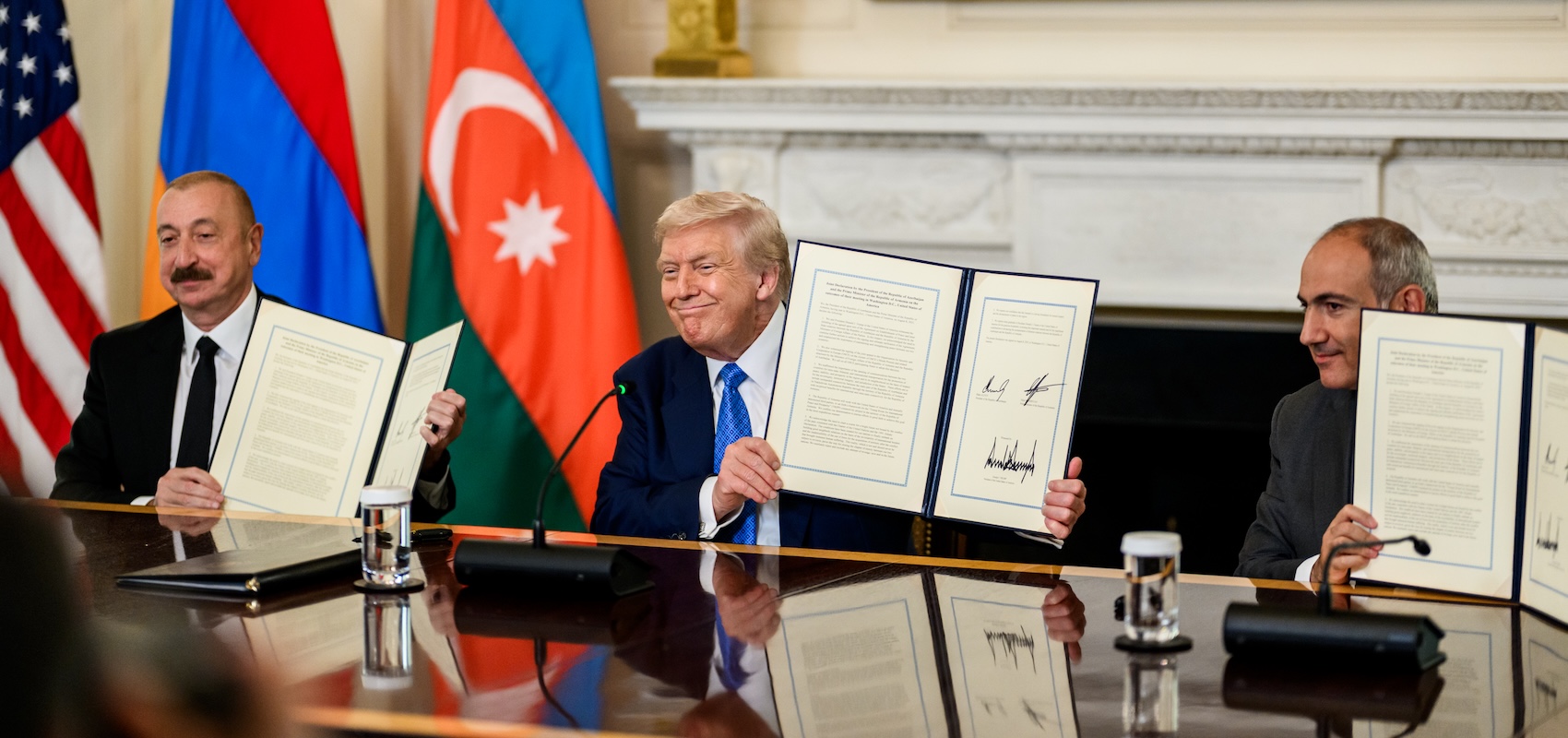
This month at the White House, Armenia’s prime minister Nikol Pashinyan and Azerbaijan’s president Ilham Aliyev shook hands on a deal that would end more than three decades of conflict. The Trump administration brokered the deal—contained in a draft peace agreement, a joint declaration, and various other memoranda—the centerpiece of which is a transit link through southern Armenia to be developed exclusively by the United States but subject to Armenian law. President Trump, characteristically, dubbed it the “Trump Route for International Peace and Prosperity,” or TRIPP.
The draft agreement contains broad commitments: mutual recognition of sovereignty and borders, a renunciation of further territorial claims, and a commitment to peaceful dispute resolution. But for all the celebration, and notwithstanding Trump’s real achievement in bringing it about, the text is not a treaty. Neither leader has signed it (their foreign ministers have initialed it) and neither country has ratified it. The deal suggests a path forward, but much remains uncertain.
The deal reflects a painful history. Karabakh, which Armenians call Artsakh, is a historically Christian Armenian region inside Muslim-majority Azerbaijan. In the 1990s, the Armenian population established de facto independence. In 2020, however, with substantial military help from Turkey and Israel, Azerbaijan retook much of the region. In 2023, after a months-long blockade, Azerbaijan seized the rest of the territory in a lightning attack. Around 120,000 Armenian Christians fled, leaving behind homes, churches, monasteries, and cemeteries that had survived centuries. The world largely ignored this ethnic cleansing.
Since then, Armenia has faced a perilous strategic environment. Azerbaijan still occupies parts of Armenia’s internationally recognized territory and routinely issues threats. In May, Secretary of State Marco Rubio warned Congress that Azerbaijan was preparing to invade Armenia. Armenia’s traditional ally, Russia, has proven unreliable, even hostile, as it tries to curry favor with the Azeri government, which provides an outlet for Russian oil that evades sanctions. Armenia has pivoted, cautiously, toward the West.
With this deal, Armenia seeks to buy time. The concessions it has made are painful, though. It formally accepts Azeri sovereignty over Artsakh, abandoning any claim to the region. The draft makes no reference to the 2023 ethnic cleansing or the possibility that refugees might one day return. Armenia agrees to withdraw legal complaints against Azerbaijan in international human rights fora. Critics see all this as a national humiliation and a betrayal of the Armenian Christians who lived and died in Artsakh for centuries—and whose churches now stand empty or desecrated.
The envisioned route through southern Armenia is also controversial. It will allow “unimpeded” transit between Azerbaijan and its exclave of Nakhichevan and, by extension, Turkey. The deal mentions reciprocal benefits for Armenian traffic on Azeri roads, but given the Azeri government’s routine anti-Armenian statements and its history of ignoring past agreements, Armenians are skeptical. Details about how Armenia and the U.S. will divide responsibilities for the road’s operation also remain unclear.
Given how favorable the deal is to Azerbaijan, one might ask why Aliyev hesitates to make it final. He claims there are indirect references to reunification with Artsakh in Armenia’s constitution that Armenia must change; Armenia denies the constitution should be read that way. The real answer likely lies in the internal dynamics of the Aliyev regime, which for decades has built its legitimacy on hostility toward Armenia and the promise of recovering Karabakh. With that goal technically achieved, Aliyev now risks losing the enemy that has long justified his rule. As commentator Eric Hacopian argues, signing a peace treaty would open the door to demands for reconciliation, rights, and democracy. Better, from Aliyev’s perspective, to keep the problem unresolved: “progress” without closure.
The deal does offer Armenia some meaningful benefits. Azerbaijan had initially demanded an extraterritorial corridor; the draft maintains Armenian sovereignty over the road. Most importantly, U.S. sponsorship of the deal pauses, at least for now, the threat of further Azeri aggression. It gives Armenia time to regroup, strengthen its military defenses, and reorient its foreign policy.
For the Trump administration, the agreement offers several advantages. It extends U.S. influence into a strategically vital region without deploying troops. The TRIPP will connect the Caspian to the Mediterranean, bypassing both Iran and Russia, while simultaneously blocking Turkey—through its alliance with Azerbaijan—from controlling the entire east-west transit route. In a world where great power competition hinges on logistics and supply chains, that matters.
There’s a domestic political dimension, too. In recent months, Christian advocacy groups close to the administration like Save Armenia have lobbied for U.S. engagement. At the White House, President Trump himself brought up the “Christians” Azerbaijan has held as prisoners since the end of the war in 2023 and pledged to ask Aliyev to release them. “I think he’ll do it for me,” Trump predicted. The choice of words—“Christians” rather than “Armenians”—suggests the influence of Christian advocacy groups.
This combination of strategic interest and faith-based solidarity makes the deal appealing to a wide range of constituencies, from foreign-policy realists to Christian conservatives. It remains to be seen, however, whether U.S. involvement will be sustained. History counsels caution. In 1920, after the collapse of the Ottoman Empire, the League of Nations offered the United States a mandate for Armenia—a protectorate that would have secured the fledgling republic’s borders and institutions. President Wilson favored it. But the Senate declined, unwilling to commit American lives or prestige to a distant nation caught between collapsing empires. Armenia conceded to the Red Army and became part of the Soviet Union.
The U.S. is again presented with an opportunity—not for military stewardship, but for economic and diplomatic engagement. The commitment required is modest by historical standards. No one expects U.S. troops on the ground, or even drones in the sky. But for Armenia the stakes remain high. Whether this agreement becomes a durable peace or merely a temporary truce will depend on whether Washington remains engaged—or again turns away.
